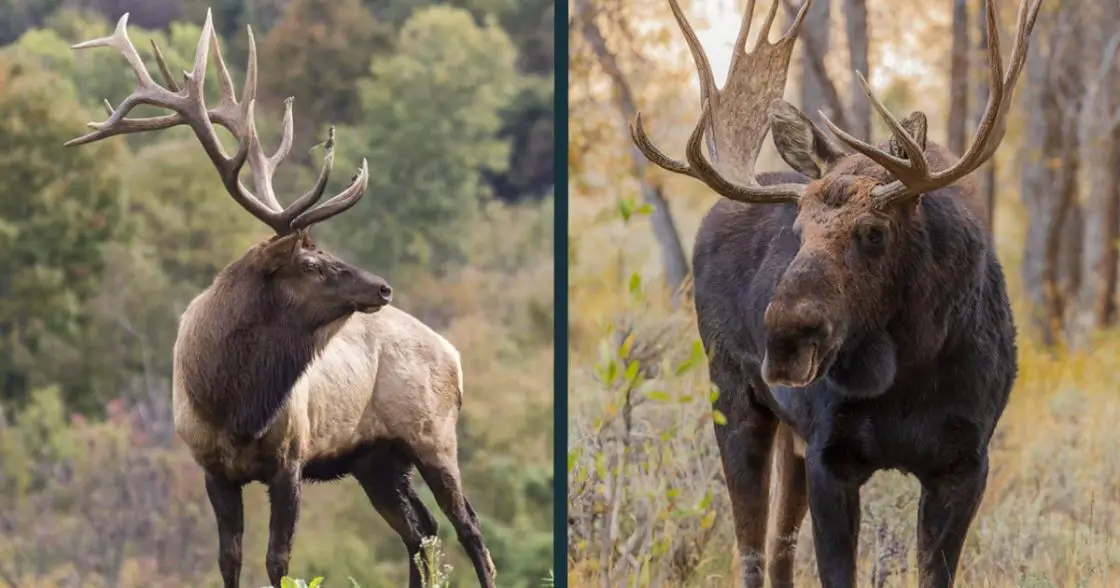The moose and the North American elk (Wapiti) have similarities. After all, they’re both large Cervids. Yet there are many differences between these two animals. We will discuss the differences between North American elk and moose. Let’s start our elk vs moose comparison by exploring some of the main differences between these large deer species below.
Elk vs Moose: The Main Differences
Like White-Tailed Deer and Mule Deer, Elk and Moose are both cervids, or members of the Cervidae family. This group of animals are hoofed ruminants of the order Artiodactyla … but that’s a lot to remember so in plain English, cervids are known simply as deer.
The North American Elk’s species name is Cervus Canadensis. Moose, on the other hand, have the species name Alces Alces, so each is a distinct species of deer. The moose is the largest deer on the planet, while the North American elk is the second largest. The elk is the largest member of the Cervus elaphus family.
Let’s explore the main differences between moose and elk.
Size Comparison
In both species, the males (bulls) are larger than the females (cows), but when comparing Moose and Elk, Moose are much larger.
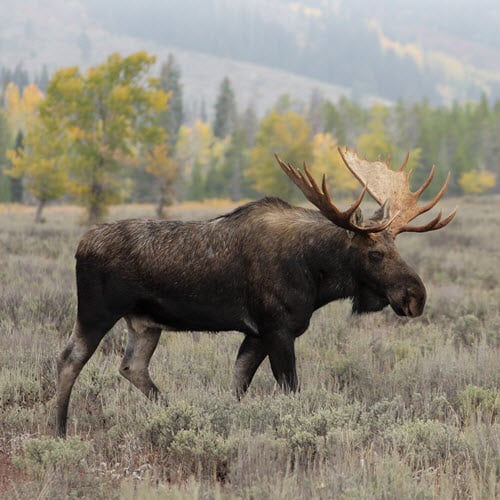
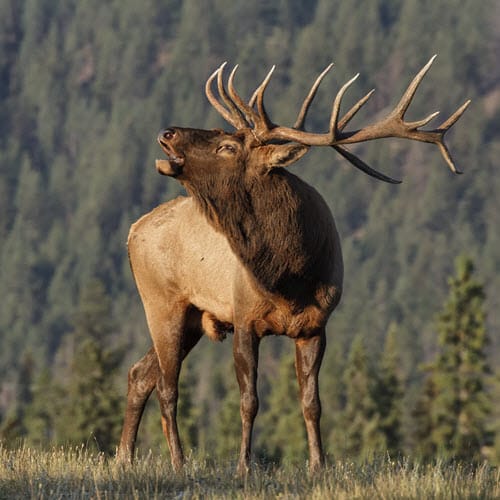
A male moose may be as tall as 6 or even 7 feet in height at its shoulders. A male elk, on the other hand, usually measures between 4 and 5 feet at its shoulders.
We see the size differentiation in weight, as well. A bull elk usually won’t exceed about 600 or 700 pounds in weight. By contrast, a bull moose may exceed 1,000 pounds in weight.
Comparing The Antlers of Moose and Elk
Elk and moose antlers are extremely different.
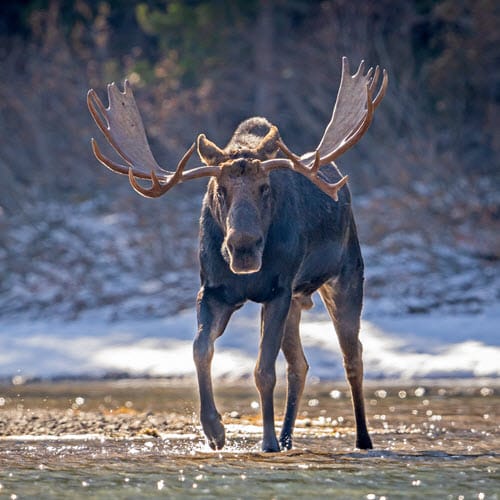
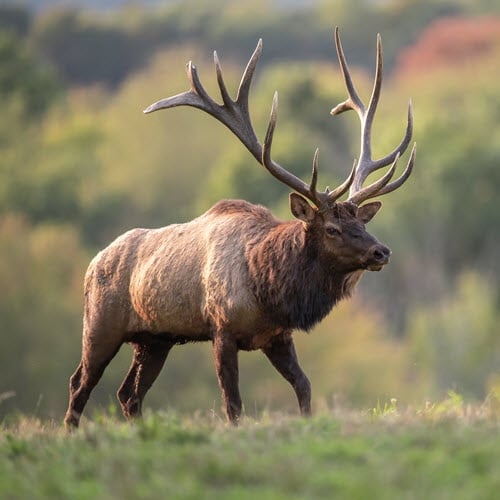
Elk antlers are quite similar in shape and design to those of the common white-tailed deer in some ways.
They are pointed and have a more elegant look than moose antlers, which are much chunkier. Moose antlers have wide, flat sections often described as “palmate.” This means they’re shaped like an open hand.
When moose are young, however, their antlers look more like those of an elk, flattening out and becoming more palmate with maturity.
Coloration
A moose’s color is primarily dark brown. In some cases, moose may look black.
Elk are usually a lighter brown color. Some individual elk may look light yellow or golden. Their coloration can vary slightly by the time of year – appearing more reddish in the warm months, and darker brown during the winter.
Face and Head
There is a difference between elk and moose in their noses, too. Elk have pointier noses, while moose noses are more rounded. The moose’s nose has a bulbous shape with great width and length.
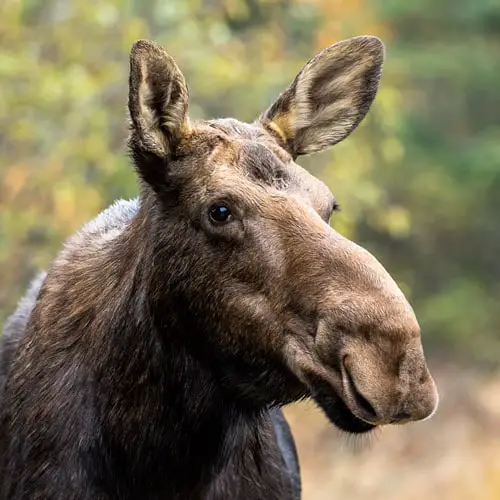
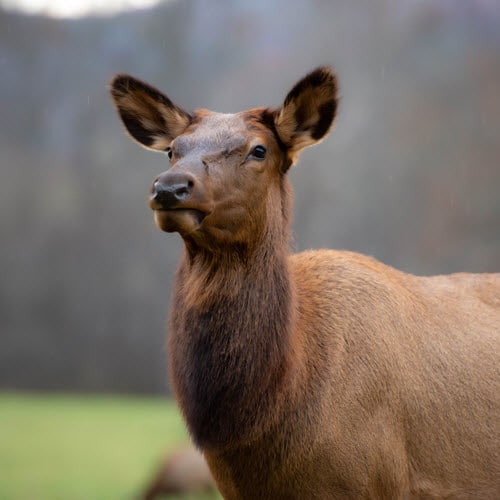
The elk’s snout is much narrower than that of a moose.
Moose also have a dewlap (a skin flap) beneath the throat. This tends to take a “bell” shape. You’ll never see this physical feature on an elk.
Habitat and Territory
Elk favor woodland habitat and territory in foothill and parkland areas. It’s just before the winter months when elk usually make their way to parkland areas as part of their annual migration.
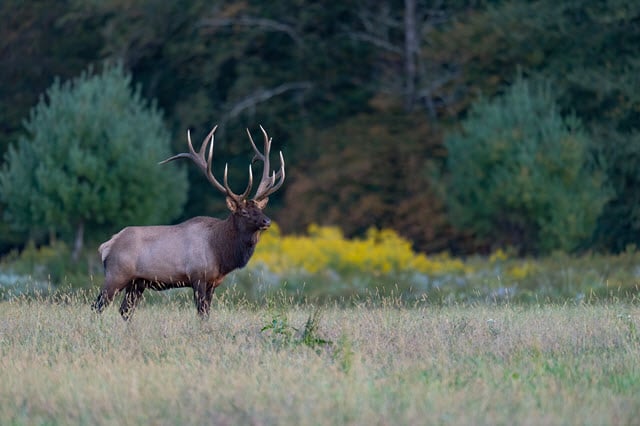
Once elk have moved onto parkland, they tend to stay together in large numbers.
Moose, on the other hand, tend to be found in spots with a lot of water, such as near lakes and rivers. They favor areas that have a lot of aquatic vegetation (their preferred food source).
Moose often go into bodies of water when they want to cool down in the summer months.
Unlike elk, moose don’t usually change their habitats at different times of the year. However, there are several different types of biomes in which moose may live.
Moose habitats include temperate forests, taiga, and tundra. These animals prefer areas where there have been disturbances (natural occurrences or even human activity) that have made their preferred vegetation easier to access and abundant in quantity. They love wetlands with plenty of aquatic vegetation.
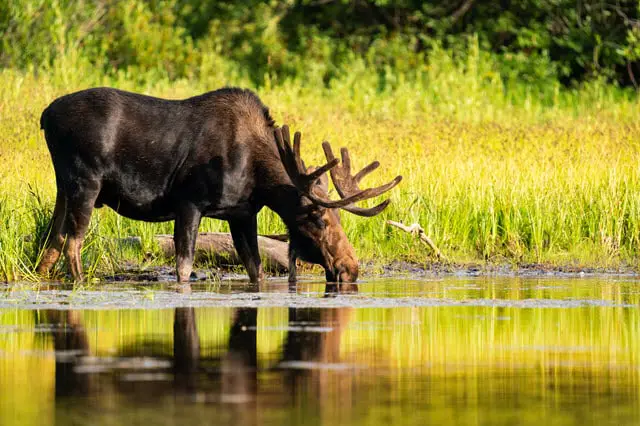
Moose strongly prefer living in places where the snow in winter reaches two feet deep. This gives them an advantage over predators thanks to their long legs.
Diet
Elk mainly eat grasses and weeds (also known as forbs). They find and eat their food by grazing, which means they travel over large spaces.
Each adult elk will probably graze across a space as large as 500 square miles. Other foods they’ll eat include bark and shrubs.
When elk are raised on a farm, they are usually set to graze on a pasture.
Unlike elk, moose don’t graze. They thoroughly explore their territory every day to find their favorite foods.
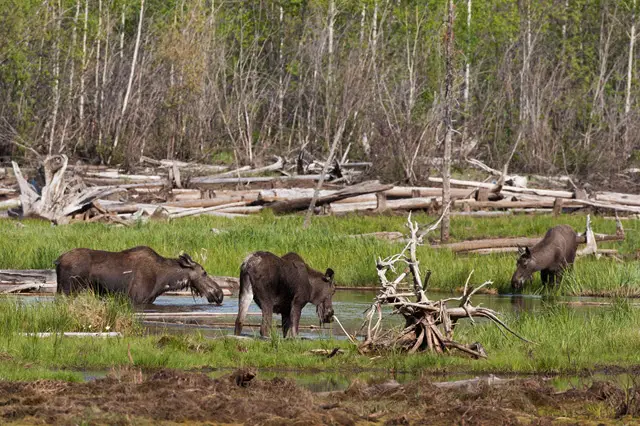
Examples of foods moose eat include forbs (weeds), fresh tree shoots, and aquatic plants. These animals will often find this last food at the bottom of lakes that have recently thawed.
It is not uncommon to see a moose wading and dipping its head below the water to seek out tender water plants below the surface. These animals are strong swimmers.
Behavior and Habits
How these animals behave is a key part of our Moose vs Elk comparison, because differences between the two are evident when observing their behavior.
Elk are herd animals and prefer to live with other deer. On the other hand, moose tend to be solitary and will often live alone.
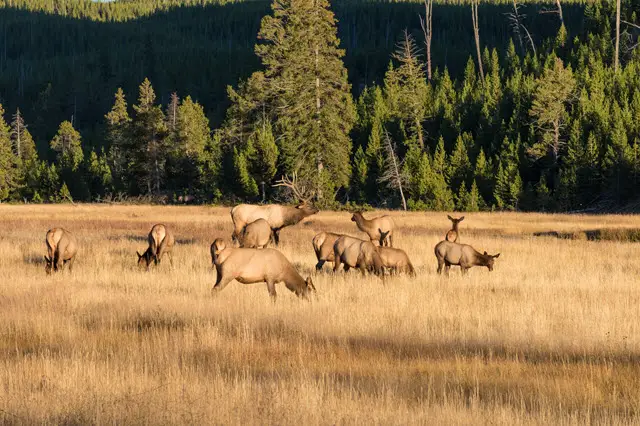
Elk almost always travel in groups or herds. Moose, on the other hand, usually travel alone.
It’s extremely rare to see several moose traveling together.
Elk do their best to stay away from people and will run away if they see them.
Moose are never alarmed by the presence of humans. In fact, they may be aggressive and dangerous.
Tracks
There is some similarity between elk and moose tracks. Moose hooves, however, have more of a heart-like shape.
Elk leave a track that is shaped more like a tooth.
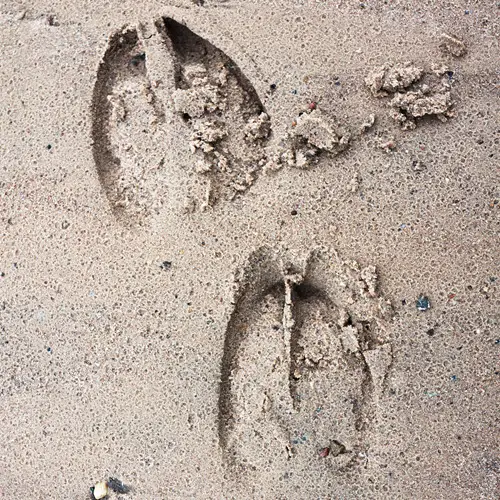
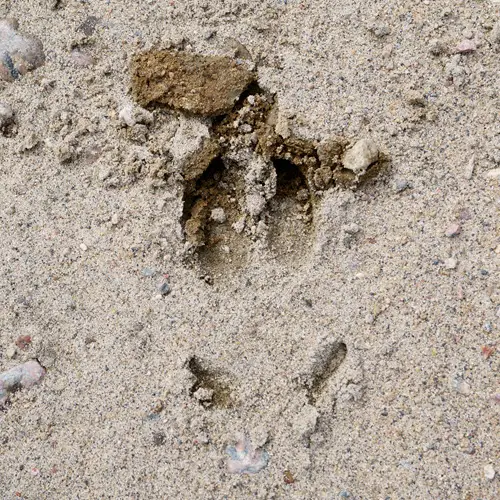
Moose hooves have toes with a sharp point, and this point at the tip tends inward. That is why moose tracks have a long heart shape.
Elk tracks are different because of the round shape of their toes. In elk hooves, each of its segments is placed parallel to the others.
This is why elk tracks look a bit like a human molar tooth.
Comparing the Sounds Made By Elk and Moose
Let’s discuss the different sounds elk and moose make.
Sounds Elk Make
North American Elk make a variety of sounds. This herd animal is extremely social and makes many different noises to communicate.
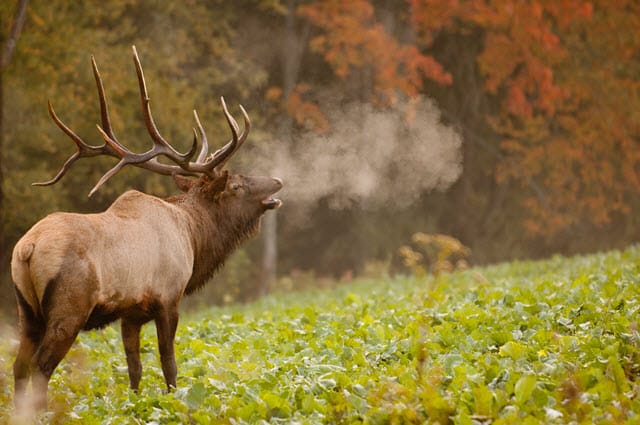
The specific sound an individual makes depends on the context.
Some elk sounds include:
- Grunt
- Squeal
- Chirp
- Bark
- Roar
- Bugle
An elk roar is made by bulls during the rut.
An elk bark sounds a little like a dog bark. If you hear an elk bark, it probably means an elk has detected you through smell or hearing. At that point, the elk will probably flee.
Elk calves make a mew sound.
And of course, the elk bull’s bugle sound is one of the best known and most distinctive animal sounds on the planet. In fact, it’s the sound many hunters think of when talking about elk.
A male elk will make this sound when trying to show dominance and scare off other males from his territory.
Sounds Moose Make
Moose make several distinct sounds, and each fits certain purposes and contexts. A common noise when moose see and greet one another is the whine.
This is a friendly noise for moose, and it usually comes from females.
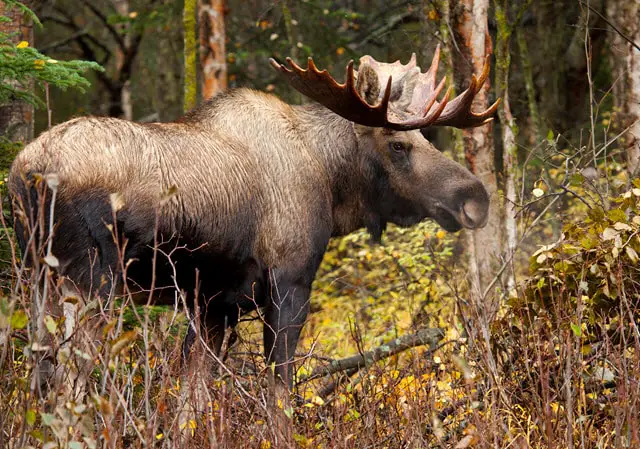
When female moose are communicating with their young (calves), they generally use low grunt noises. In the breeding season, female moose use extended calls specifically to let bull moose know they’re in the area.
Bull moose often grunt when they’re trying to expel other male moose from their territory or if they’re looking for a female. If a moose is angry, it makes short, deep-toned grunts produced at two or three-second intervals.
These have been described as resembling loud coughing noises.
Elk vs Moose Comparison Chart
Below is a quick comparison chart showing the differences between elk and moose.
| Characteristic | Moose (male) | Moose (female) | Elk (male) | Elk (female) |
|---|---|---|---|---|
| Average Weight (Pounds) | 1,106 lbs | 840 lbs | 700 lbs | 500 lbs |
| Average Length (Meters) | 3.2 meters | 2.4 meters | 2.4 meters | 2 meters |
| Average Height (Meters) | 1.82 meters | 1.4 meters | 1.5 meters | 1.3 meters |
| Color | Dark Brown and Black | Dark Brown and Black | Brown to Golden | Brown to Golden |
| Aggression | Low (but high if they feel threatened) | Low (but high if they feel threatened) | Very Low | Very Low |
| Behavior | Slow and Solitary | Slow and Solitary | Timid and Herd-Oriented, and Fast | Timid and Herd-Oriented, and Fast |
| Speed | Slow and not likely to run away | Slow and not likely to run away | Fast and nervous, will run away from humans | Fast and nervous, will run away from humans |
| Antlers | Moose have flat, broad antlers | Moose have flat, broad antlers | More spindly antlers with pointed shapes | More spindly antlers with pointed shapes |
| Tracks | Moose tracks resemble an elongated heart | Moose tracks resemble an elongated heart | Elk tracks slightly resemble a human molar tooth. | Elk tracks slightly resemble a human molar tooth. |
| Sounds | Moose primarily make a variety of sounds, such as low grunts. If a moose is angry, it will make intimidating short, deep-toned grunts. The specific noise a moose makes depends on their emotions and the context. As bull (male) moose are more aggressive than females, they will often make louder and more aggressive noises, to intimidate rivals and threats. | Moose primarily make a variety of sounds, such as low grunts. If a moose is angry, it will make intimidating short, deep-toned grunts. The specific noise a moose makes depends on their emotions and the context. A moose whine is a friendly noise. Females are usually the moose making this noise. | Male elk make a variety of noises, including grunts, squeals, chirps, barks, roars, and the famous bugle. | Female elk make a variety of noises, including mews, grunts, squeals, chirps, barks, and the estrus scream. |
| Diet | Moose mainly eat forbs (weeds), fresh tree shoots, and aquatic plants. They often find aquatic plants at the bottom of recently thawed lakes. | Moose mainly eat forbs (weeds), fresh tree shoots, and aquatic plants. They often find aquatic plants at the bottom of recently thawed lakes. | Elk are grazers. Elk primarily eat forbs (weeds) and grasses. | Elk are grazers. Eat primarily eat forbs (weeds) and grasses. |
Where Do Moose and Elk Live in North America?
When comparing North American elk vs moose, you’ll find that these two different species inhabit different places on the continent.
Here we’ll learn about the regions of North America where moose and elk live.
Moose Regions
The largest moose population is in the forests of Canada. There is also a significant number of moose in the northern United States, stretching from Maine all the way to Washington State.
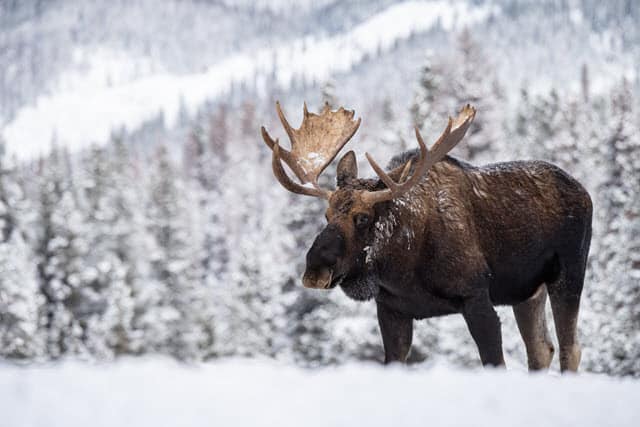
They also live in Alaska.
Moose cannot sweat and are unable to naturally regulate body heat. They cannot tolerate regions where the temperature stays 80 degrees Fahrenheit or higher for extended periods of time.
Elk Regions
Today, North American elk are found in the Canadian provinces of British Columbia, Alberta, and Manitoba. The largest population is in British Columbia.
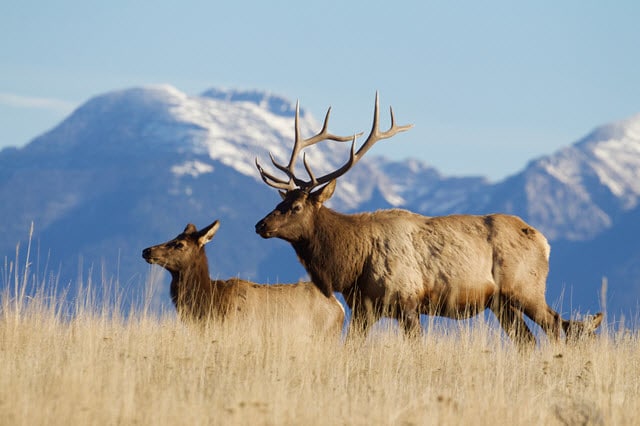
In fact, more than half of all the elk in North America are in that province.
Hundreds of years ago at the time of European and Native North American contact, elk had a much larger distribution than they do today. As well as the prairie provinces, they lived all the way across the southern part of Quebec, as well as in the upper St. Lawrence region and Ontario.
Comparing Moose vs Elk Populations
Let’s learn about elk and moose population numbers.
Elk Population
The lowest elk population numbers ever were at the turn of the 20th century. Later on, programs reintroducing elk into their old ranges were successful in increasing populations.
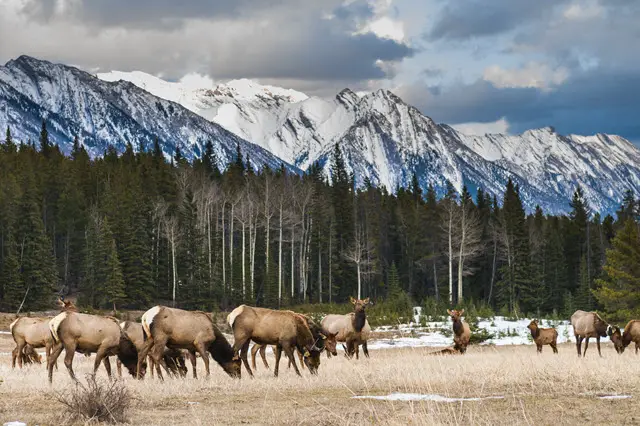
However, the numbers are still too low. Today, there are estimated to be around 72,000 elk in Canada. Efforts to improve and grow elk populations continue in North America.
Most of these animals are in the province of British Columbia, where there are believed to be around 40,000 elk.
There are believed to be 20,000 elk in the province of Alberta, and there are approximately 7,000 elk in Manitoba.
Moose Population
The moose population is in a much better position than we see with elk. In fact, there are believed to be at least 500,000 or perhaps even more than one million moose currently in Canada.
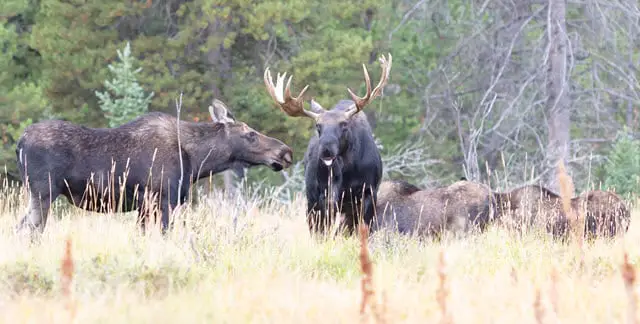
There is also a moose population in the United States, and that is estimated to be around 300,000.
Is the Eurasian Elk Actually a Moose?
Yes, it is. The animal referred to as the “Eurasian elk” is actually a moose. This is part of the reason you may have some confusion about the two terms. You’ll sometimes hear moose in this part of the world called the Eurasian moose, or simply an elk.
The “Eurasian elk” (Eurasian moose) lives in many areas of Scandinavia and in the region moving towards Siberia.
It’s also found in some areas of the European mainland and Asia. Examples of countries where the “Eurasian elk” lives include Germany, Poland, Latvia, Estonia, China, Lithuania, Mongolia, and Kazakhstan.
Final Comparison of Elk vs Moose
Now you know all the moose vs elk differences, you’ll never confuse these two animals again.
Let’s review the primary differences between elk and moose:
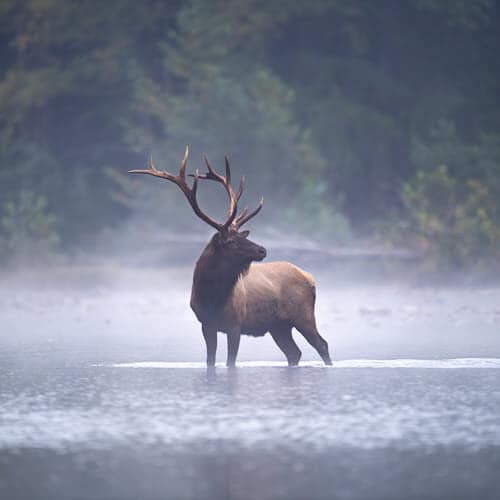
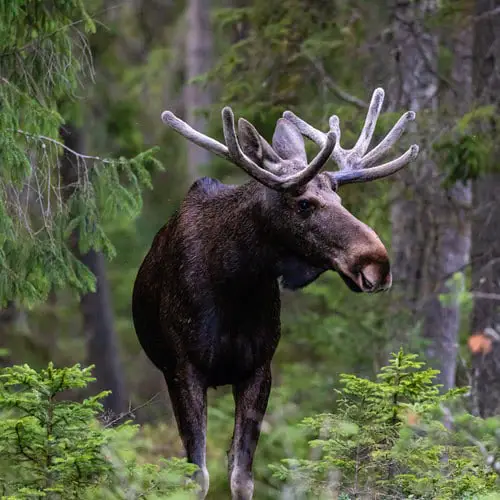
Size
Moose are much larger than elk, in both height and weight. In both species, the males (bulls) are larger than the females.
Antlers
Moose have broader, palmate antlers while elk have antlers more like white-tailed deer. In other words, elk antlers are more elegant and spindly.
Moose antlers have a much chunkier look. In fact, they’re flat and broad.
They have a similar shape to an open hand, which is why they’re referred to as “palmate.”
Habitats
Moose enjoy habitats with access to marsh or bodies of water, such as rivers and lakes. They need access to aquatic vegetation, and they are great swimmers.
Elk prefer parkland and wooded habitats. They tend to live in parkland in the winter months.
At other times of the year, elk often live in foothill areas.
Behavior and Habits
Moose are solitary while elk live in herds. Another major difference is that elk are skittish and will avoid people while moose aren’t at all alarmed by our presence.
In fact, they may even be aggressive and cause human injury or even death.

